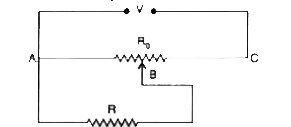A proton and a deuteron are accelerated through the same accelerating potential. Which one of the two has :
(a) Greater value of de-Broglie wavelength associated with it, and
(b) Less momentum ?
Give reasons to justify your answer.Solution in Kannada
(a) de-Broglie wavelength is given by
λ=h√2mqV
As mass of proton < mass of deuteron and qp=qd and v is same
⇒λp>λd for same accelerating potential.
(b) Momentum =hλ
∴λp>λd
∴ Momentum of proton will be less, than that of deutron.
Topper's Solved these Questions
- DUAL NATURE OF RADIATION AND MATTERBOOK - OSWAAL PUBLICATIONCHAPTER - DUAL NATURE OF RADIATION AND MATTEREXERCISE - TOPIC-2 DE-BROGLIE RELATION (SHORT ANSWER TYPE QUESTIONS-II)
2 Videos
- DUAL NATURE OF RADIATION AND MATTERBOOK - OSWAAL PUBLICATIONCHAPTER - DUAL NATURE OF RADIATION AND MATTEREXERCISE - TOPIC-2 DE-BROGLIE RELATION (LONG ANSWER TYPE QUESTIONS)
1 Videos
- DUAL NATURE OF RADIATION AND MATTERBOOK - OSWAAL PUBLICATIONCHAPTER - DUAL NATURE OF RADIATION AND MATTEREXERCISE - TOPIC-2 DE-BROGLIE RELATION (VERY SHORT ANSWER TYPE QUESTIONS)
8 Videos
- CURRENT ELECTRICITY BOOK - OSWAAL PUBLICATIONCHAPTER - CURRENT ELECTRICITY EXERCISE - TOPIC-3 (POTENTIOMETER & APPLICATIONS) (NUMERICAL PROBLEMS)
2 Videos
- ELECTRIC CHARGES & FIELDSBOOK - OSWAAL PUBLICATIONCHAPTER - ELECTRIC CHARGES & FIELDSEXERCISE - (TOPIC -2)Numerical Problems
5 Videos
Similar Questions
An electron and a photon each have a wavelength of 1.00 nm. Find (i) their momentum (ii) the energy of the photon and (iii) K.E of electron
View SolutionWhat are matter waves? Derive an expression for the de Broglie wave length.
View SolutionA proton and an electron have same kinetic energy. Which one has smaller de-Broglie wavelength ?
View SolutionA resistance of RΩ draws current from a potentiometer. The potentiometer has a total resistance R0Ω.A voltage V is supplied to the potentiometer. Derive an expression for the voltage across R when the sliding contact is in the middle of the potentiometer.

View SolutionAn atom was earlier assumed to be sphere of radius a having a positively charged point nucleus of charge +Ze at its centre . This nucleus was believed to be surrounded by a uniform desity of negative charge that made the atom neutral as a whole.
Use this theorem to find the electric field of this atom at a distance r(r>a) from the centre of the atom.
View SolutionA proton and deuteron are accelerated by same potential difference.Find the ratio of their de-Broglie wavelengths.
View SolutionA proton and alpha particle are acclerated through the same accelerating potential. Which one of the two has (a) greater value of de-broglie wavelength associated with it, and (b) less kinetic energy? justify your answer.
View SolutionAn electron and a proton are accelerated through the same potential. Which one of the two has (i)b greater value of de-Broglie wavelength associated with it and (ii) less momentum?justify your answer.
View SolutionA proton and deutron are acclerated through the same accelerating potential. Which one of the two has (a) greater value of de-broglie wavelength associated with it, and (b) less momentum? Give reasons to justify your answer.
View SolutionAn electron and a proton are accelerated through the same potential. Which one of the two has (i) greater value of de Broglie wavelength associated with it and (ii) less momentum? Justify your answer.
View SolutionA proton and an alpha particle are accelerated through the same potential difference. Which one of the two has greater de Broglie wavelength,
View SolutionA deuteron and an alpha particl are accelerated with the same potential. Which one of the two has greater value of de Broglie wavelength associated with it and i
View SolutionA proton and deutron are accelerated through the same accelerating potential. Which one of the two has (a) greater value of de-broglie wavelength associated with it, and (b) less momentum? Give reasons to justify your answer.
View SolutionA proton and a deuteron are accelerated through the same accelerating potential. Which one of the two has less momentum? Give reasons to justify your answer.
View SolutionA proton and alpha particle are accelerated through the same accelerating potential. Which one of the two has (a) greater value of de-broglie wavelength associated with it, and (b) less kinetic energy? justify your answer.
View Solution
